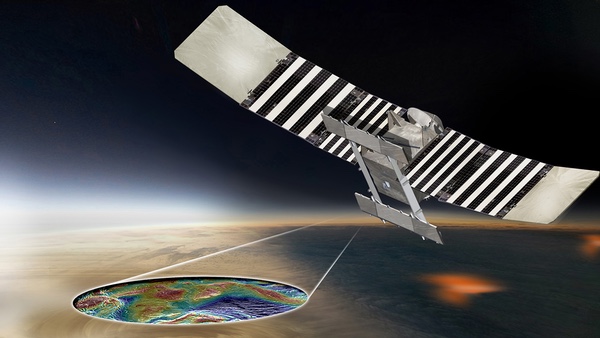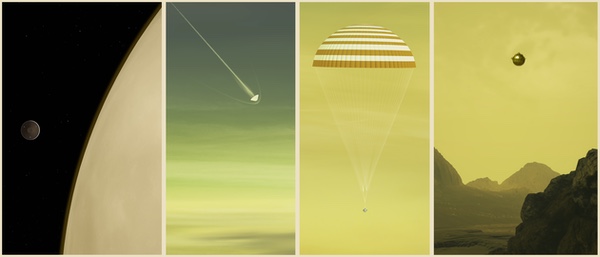Venus is hot againby Jeff Foust
|
| “These two sister missions both aim to understand how Venus became an inferno-like world capable of melting lead at the surface,” Nelson said. |
That optimism vaporized in early January 2017. NASA announced it instead selected two asteroid missions—Lucy to explore the Trojan asteroids leading and following Jupiter in its orbit around the Sun, and Psyche to the metallic main belt asteroid of the same name—for development. In addition, a third mission, a space telescope to search for near Earth asteroids called NEOCam, received funding to continue work on key detector technology. The two Venus missions, called DAVINCI and VERITAS, were shut out.
It’s understandable, then, that Venus scientists went into this latest Discovery competition with perhaps a more guarded mindset. Once again, two Venus missions, updated versions of DAVINCI and VERITAS, has made the cut as finalists, joined by the Io Volcano Observer and Trident, a mission to fly by Neptune’s large moon, Triton. And, once again, NASA planned to select two missions, raising the hopes that at least one Venus mission would be selected. But history showed that good odds were no guarantee.
NASA officials had indicated they would select up to two missions in the summer but didn’t give a specific deadline. However, at the meeting of the National Academies’ Space Studies Board May 26, members suggested an announcement was coming soon. “We’ll know by this time next week,” said Darby Dyar of Mount Holyoke College and chair of NASA’s Venus Exploration Analysis Group (VEXAG).
A week later, the rumor mill was now in high gear, with an announcement of the winning Discovery missions expected June 2, the same day as new NASA administrator Bill Nelson gave his first “State of NASA” address. It would seem to be the logical place to make such an address.
Nelson took the stage at NASA Headquarters on the afternoon of June 2, but spent a half-hour talking about other agency priorities, from the new Earth System Observatory program to the Space Launch System. There was even a video narrated by William Shatner who talked about the importance of exploration. “The purpose of life on Earth is to see, to know, and to tell what the cosmos has to offer. Without us human beings, without NASA, the universe would be unseen, unknown, untouched,” said the actor who, as Star Trek’s Captain Kirk, saw, knew, and, well, touched a lot of other life forms.
Finally, at the very end, Nelson turned to the Discovery program. “I’m excited to break some big news today,” he said, as the planetary science community sat on the edges of their chairs. “We have two new Discovery missions to announce.”
The announcement was actually in the form of a video that announced the destination in its opening frames: “Venus.” DAVINCI+ and VERITAS had won at last, selected for launch by late this decade at a cost of $500 million each, plus launch and operations.
“These two sister missions both aim to understand how Venus became an inferno-like world capable of melting lead at the surface,” he said. “They will offer the entire science community the chance to investigate a planet we haven’t been to in more than 30 years.”
| “Venus is a ‘Rosetta stone’ for reading the record books of climate change, the evolution of habitability, and what happens when a planet loses a long period of surface oceans,” said Garvin. |
While they were announced as a complementary pair of missions, the two were selected separately, not as a combination. “We focused on what the science return was,” said Thomas Zurbuchen, NASA associate administrator for science, in a briefing after the State of NASA address. “The missions, even though they happen to go to the same planet, they’re really massively different.”
“At the end,” he said of DAVINCI+ and VERITAS, “those two swung in terms of science return and programmatic match to the top.”
It helped, he added, that both had gone through the Discovery competition before. “I hardly recognized the proposal,” he said of VERITAS in particular. “The science was just so much better.”
While paired up in the Discovery announcement, the two missions share little beyond the same destination—and same love for convoluted acronyms. DAVINCI+, or Deep Atmosphere Venus Investigation of Noble gases, Chemistry, and Imaging Plus, will send to Venus an atmospheric probe about one meter across. It will plunge into the planet’s atmosphere, collecting information about its composition as well as taking high-resolution images of a region called Alpha Regio, an ancient highland. (The camera was added at DAVINCI’s previous Discovery proposal, and is why it has a “+” in its name now.)
DAVINCI+ features a host spacecraft that will first make two flybys of Venus, measuring atmospheric circulation and heat emission. On the third approach, it will release the probe, which will descend for an hour before landing at Alpha Regio.
“Venus is a ‘Rosetta stone’ for reading the record books of climate change, the evolution of habitability, and what happens when a planet loses a long period of surface oceans,” said James Garvin, principal investigator (PI) for DAVINCI+ at NASA’s Goddard Space Flight Center, in a statement. (Lori Glaze, the previous PI for DAVINCI, is now the director of NASA’s planetary sciences division, and recused herself from the Discovery selection process.) “But Venus is hard since every clue is hidden behind the curtain of a massive opaque atmosphere with inhospitable conditions for surface exploration, so we have to be clever and bring our best tools of science to Venus in innovative ways with missions like DAVINCI+”
 VERITAS will orbit Venus and use radar and thermal infrared instruments to study its surface. (credit: NASA/JPL-Caltech) |
VERITAS, or Venus Emissivity, Radio Science, InSAR, Topography, and Spectroscopy, is an orbiter mission. It carries a synthetic aperture radar to map the surface, improving on the maps generated by Magellan—NASA’s last dedicated Venus mission, which launched in 1989 and ended in 1994. It also carries a German instrument to map infrared emissions from the surface to help scientists identify rock types and to search for active volcanoes.
“To unwrap the mysteries of Venus we have to look under the hood at Venus’ interior; it is the engine for global geologic and atmospheric evolution,” said Suzanne Smrekar, PI for VERITAS at JPL, in a statement.
For Venus scientists who had their hopes dashed in 2017, getting not one but two missions selected in this Discovery competition was a celebration. Dyar, besides leading VEXAG, is a deputy PI on VERITAS, having been working on various Venus mission concepts for 10 years.
“When I heard the news that VERITAS had been selected, I cried and got goosebumps. It’s amazing when you work on something for more than ten years and it finally comes to fruition,” she said. “I am raring to go. We know exactly what we want to do, and how we will do it!”
For Dyar and many other scientists, the last few decades have been frustrating ones for studying Venus. After a wave of missions by the United States and former Soviet Union in the early decades of the Space Age, interest by governments dried up like the oceans the planet may have once harbored. Since Magellan, scientists have had only a couple dedicated missions—Europe’s Venus Express and Japan’s Akatsuki—as well as data collected on gravity assist flybys of missions bound elsewhere in the solar system.
Those early missions showed Venus to be a truly inhospitable world today, and a challenging one technically to study. At the same time, though, interest shifted to Mars, which is inhospitable in different ways but remains a long-term goal for human spaceflight.
“I think Venus us the most underrated planet in our solar system,” said Peter Beck, chief executive of Rocket Lab, during a webinar last month by Bessemer Venture Partners. “Mars gets all of the science because you can put boots on the surface of Mars. That is a fact. You’re not going to put boots on the surface of Venus. So, politically, it’s not nearly as exciting.”
| “When I heard the news that VERITAS had been selected, I cried and got goosebumps. It’s amazing when you work on something for more than ten years and it finally comes to fruition,” Dyar said. |
Beck has been leading a privately developed mission to Venus, using his company’s Electron rocket and Photon smallsat bus, that could launch as soon as 2023. It would plunge into the planet’s atmosphere to study its composition, including search for any traces of phospine, a gas whose discovery last years raised the prospects that the planet, or at least regions of its upper atmosphere, are habitable (see “Photons and phosphine”, The Space Review, September 28, 2020.)
The detection of phosphine remains controversial, though, and doesn’t seem to have affected the selection of DAVINCI+ and VERITAS, whose proposals predate the phosphine detection. But another factor is that studying Venus can help scientists understand planetary evolution, both in our solar system and among the growing population of exoplanets.
“We observe these exoplanets all over our galaxy, and a number of them are Venuses: very thick atmospheres,” Zurbuchen said. “The overall case for Venus has moved in the favor of Venus because of the many questions astrophysicists are asking.”
“Venus is the ‘exoplanet in our backyard’ that can help us understand these distant analog worlds by providing ground truth to improve the computer models we will use to interpret exo-Venus planets,” said Giada Arney of NASA Goddard, deputy PI on DAVINCI+. “Excitingly, if Venus was habitable in the past, some exo-Venus planets may be habitable too! So DAVINCI+’s investigation of the evolution of Venus may help us better understand how habitable worlds are distributed elsewhere in the universe, and how habitable planets evolve over time in a general sense.”
Nelson, just a month into the job as NASA administrator, said scientists were excited about the selection of the two Venus missions. But at the briefing after his State of NASA adders, he did have a question. “Why the name DAVINCI on this particular mission?” he asked Zurbuchen.
Zurbuchen responded that the mission is “about the spirit that was da Vinci: coming up with innovative new ideas. The team really felt that vest summarized what they really cared about.”
As Garvin put in it the statement about his mission’s selection, the name reflects “Leonardo da Vinci’s inspired and visionary Renaissance thinking that went beyond science to connect to engineering, technology, and even art.”
Another name comes to mind for either Venus mission, except that NASA’s latest Mars rover is already called Perseverance.
Note: we are using a new commenting system, which may require you to create a new account.
